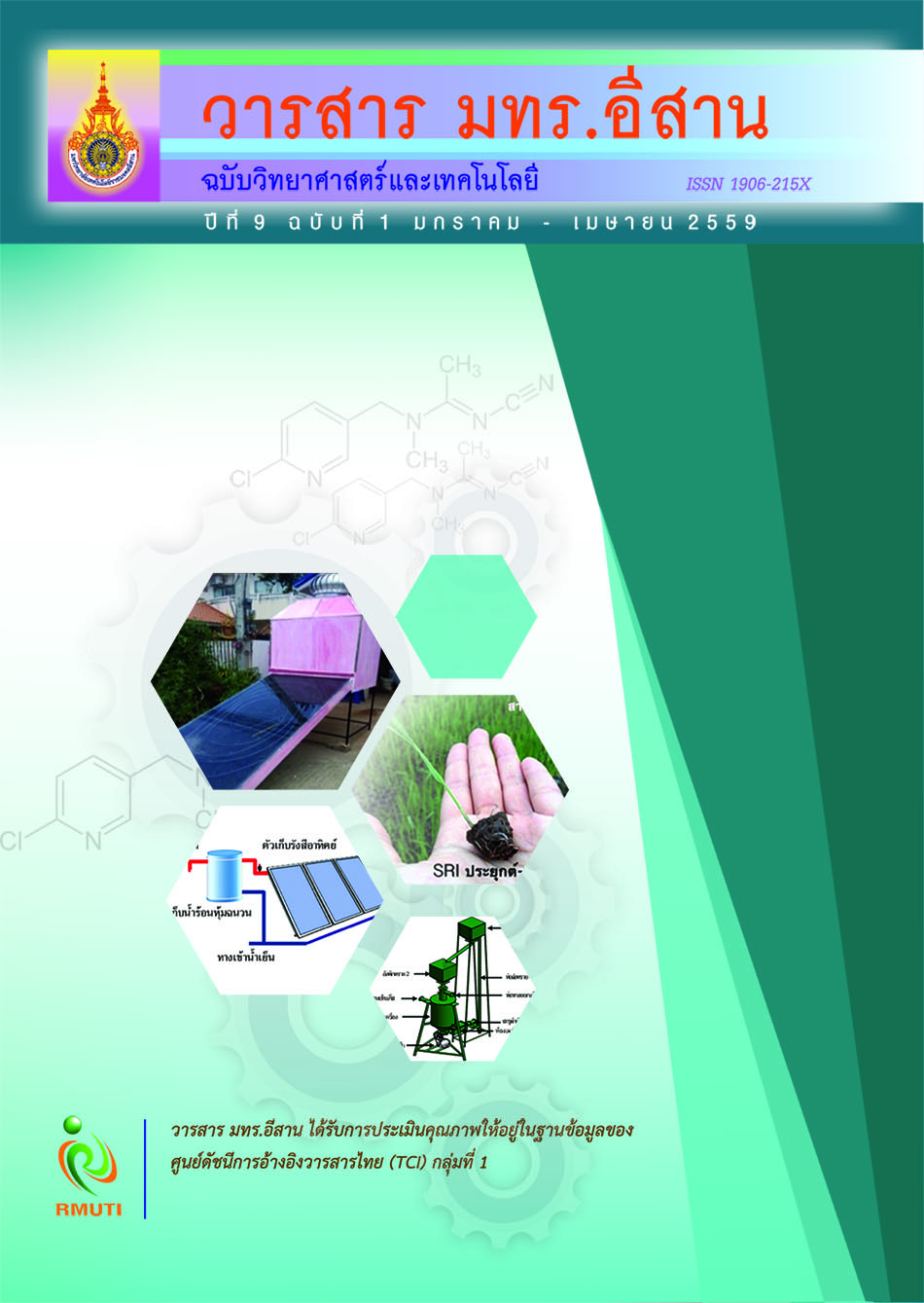การเพาะข้าวกล้องไรซ์เบอร์รี่งอกด้วยระบบเพาะข้าวกล้องอัตโนมัติร่วมกับระบบนํ้าร้อนพลังงานแสงอาทิตย์ (A Producing the Germinated Brown Rice (Rice-Berry) by using an Automatic Process and Hot Water from Solar Collector System)
Main Article Content
Abstract
บทคัดย่อ
งานวิจัยนี้มีวัตถุประสงค์เพื่อทดสอบการผลิตข้าวกล้องงอกพันธุ์ไรซ์เบอร์รี่ด้วยระบบการเพาะอัตโนมัติ
ร่วมกับการใช้นํ้าร้อนจากระบบผลิตนํ้าร้อนพลังงานแสงอาทิตย์ ซึ่งสามารถช่วยลดระยะเวลาในการเพาะ
ข้าวกล้องและภาระค่าไฟฟ้าได้ กระบวนการทดสอบแบ่งออกเป็น 3 ส่วน คือ การทดสอบการเพาะข้าวกล้อง
ด้วยวิธีแบบดั้งเดิม การทดสอบการเพาะข้าวกล้องด้วยระบบเพาะอัตโนมัติ การวิเคราะห์หาเปอร์เซ็นต์
การงอกของข้าวกล้อง
กระบวนการทำงานของระบบเริ่มต้น รับนํ้าร้อนจากระบบผลิตนํ้าร้อนพลังงานแสงอาทิตย์ที่มี
อุณหภูมิสูงกว่า 50oC เพื่อนำมาผสมกับนํ้าอุณหภูมิปกติในถังเพาะข้าวกล้องให้ได้อุณหภูมิประมาณ 40oC
จากนั้นนำข้าวกล้องบรรจุลงถาดเพาะข้าวกล้อง แช่นํ้าอุ่นในถังเพาะข้าวกล้อง เป็นระยะเวลาตามกำหนด
โดยมีวงจรไมโครคอนโทรลเลอร์ทำหน้าที่ควบคุมระดับนํ้า อุณหภูมิ และเวลาให้อยู่ในระดับที่ตั้งไว้
เมื่อครบกำหนดระบบจะระบายนํ้าทิ้งและเข้าสู่กระบวนการหมักข้าว จนกระทั่งครบตามเวลาที่กำหนดไว้
ผลการทดลองพบว่า กระบวนการเพาะข้าวกล้องด้วยระบบเพาะอัตโนมัติให้เปอร์เซ็นต์การงอก
ของข้าวกล้องที่ 90.51% ซึ่งใกล้เคียงกับกระบวนการเพาะด้วยวิธีดั้งเดิม แต่เวลาแช่ข้าวและหมักข้าว
ใช้เวลารวมกัน 24 ชั่วโมง ซึ่งสั้นกว่ากระบวนการเพาะแบบดั้งเดิมถึงหนึ่งเท่าตัว ขณะที่เปอร์เซ็นต์ข้าวกล้อง
ที่ไม่งอกประมาณ 4% ในส่วนของการลดการใช้พลังงานจากไฟฟ้า ระบบผลิตนํ้าร้อนสามารถประหยัด
พลังงานได้ประมาณ 233 kWh ต่อปี และมีระยะเวลาคืนทุนอยู่ที่ 0.56 ปี
Abstract
The purpose of this research is to test a producing the Germinated Brown Rice (GBR)
by using an automatic process worked with a hot water from solar collector system.
This system not only decreases a process time, but also can decreases an electricity usage.
The experiments comprise of experiment of traditional producing the GBR, experiment
of automatic producing the GBR and percentage analysis of the GBR.
Hot water above 50oC of solar collector system is fed to a process tank and
mixed with cool water to maintain the temperature around 40oC. The Brown Rice (BR)
are contained on the container and placed in the process tank. The BR is soaked by
programmable time. The mixed water is let out of the process tank when finish time
while the BR are left in process tank to ferment by programmable time. On the process
tank, a microcontroller controls soaking time, soaking temperature, water level and
fermentation time are involved.
The experimental results show that the percentage of GBR which produced
by automatic system as 90.51%, closely with the percentage of GBR of traditional method
but process time, soaking time and ferment time, is shorter than a half. In part of the BR
that can not germinate less than 4%. Finally, energy consumption saves 233 kWh/year
and payback period as 0.56 year.
Article Details
References
Paddy Rice. In The 23rd Conference on Mechanical Engineering Network of
Thailand. Chaing-mai : Faculty of Engineering Chaing-mai University
Jarurat, S., Voranuch, S. and Ratchada, T. (2007). Effect of Soaking and Germinating
Processes on Gamma-Aminobutyric Acid (GABA) Content in Germinated Brown
rice (Khom mali 105). Agricultural science journal. Vol. 28. No. 5. pp. 164-167
Kaosa-ard, T. and Songsermpong, S. (2012). Influence of germination time on the GABA
content and physical properties of germinated brown rice. Asian Journal of Food
and Agro-Industry. Vol. 5. No. 4. pp. 270-283
Komatsuzaki, N., Tsukahara, K., Toyoshima, H., Suzuki, T., Shimizu, N. and Kimura, T.
(2007). Effect of soaking and gaseous treatment on GABA content in germinated
brown rice. Journal of Food Engineering. Vol. 78. No. 1. pp. 556-560
Nongnuch, W. (2012). Germinated Brown rice processing. Rusamelae Journal. Vol. 33.
No. 2. pp. 57-62.
Rawat, K., Umphisak, T. and Pisit, T. (2005). Uncovered glass solar Water Heater. KKU
Engineering Journal. Vol 33. No. 1. pp. 55-66
Rice Department of Thailand. (2009). Miracle of Thai rice: Germinated brown rice.
1st Edition. Bangkok : Agricultural cooperative printing demonstrations of Thai Ltd.
Patcharee, T., Warunee, V., Vipa, S. and Ladda, W. (2006). Accumulation of gamma-
aminobutyric acid (GABA) in non-waxy and waxy rice germ during water
soaking. Food Engineering. Fuaculty of Engineering. Kasetsart University
Sakolkarn, D. and Apinya, P. (2009). Semi-Automatic a germinated brown rice producer.
Desertation of Agricultural engineering. Faculty of Engineering at Kamphaeng
Saen. Kasetsart University
Sunan, P., Sarawut, S., Benjawan, P. and Sukanda, S. (2010). Study and Design of a Small
Germinated Brown Rice Machine for Home. Journal of Engineering RMUTT.
Vol. 8. No. 1. pp. 61-68
Thanarat, S. (2001). Solar Water Heating. Energy World Journal Chaing-mai University.
Vol. 10. No. 4. pp. 30-38
Varanyanoud, W., Tungtrakul, P., Surojanamekakul, V., Watanasirithum, L. and Luxiang, W.
(2005). Effect of water soaking on gamma aminobutyric acid in germ of different
Thai rice varieties. Kasetsart J. (Nat. Sci.). Vol. 39. pp. 411-415


